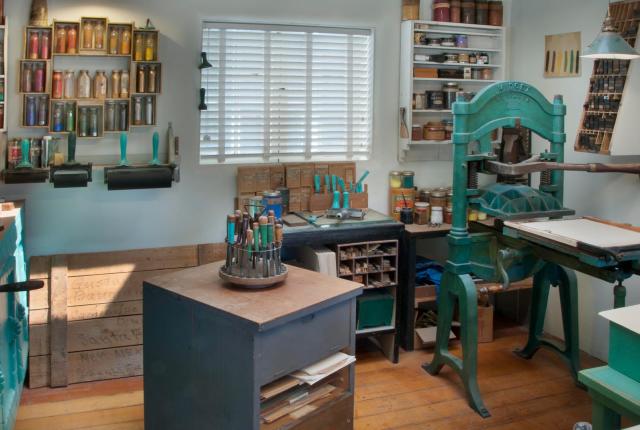Above: A re-creation of Gustave Baumann’s studio inside the Palace Print Shop at the New Mexico History Museum. Courtesy of the Palace Press (NMHM/DCA), Photo by Blair Clark.
ON SATURDAY, OCTOBER 12, 1918, The Santa Fe New Mexican reported, “Gustave Baumann, the noted artist, arrived from Taos yesterday and will spend a few days in Santa Fe before heading east to Chicago and New York.”
By week’s end, the news about the German-born printmaker was outdated. Captivated by New Mexico, Baumann (1881–1971)—who had immigrated to Chicago at age 10 and had been living in Indiana for several years—became a Santa Fean for the rest of his life. In woodblock prints blooming with ocher adobe buildings, purple skies, and buttery autumn cottonwoods, bordered whimsically by a signature dotted outline, he stamped an enduring vision of New Mexico that’s sought by collectors and graces countless calendars.
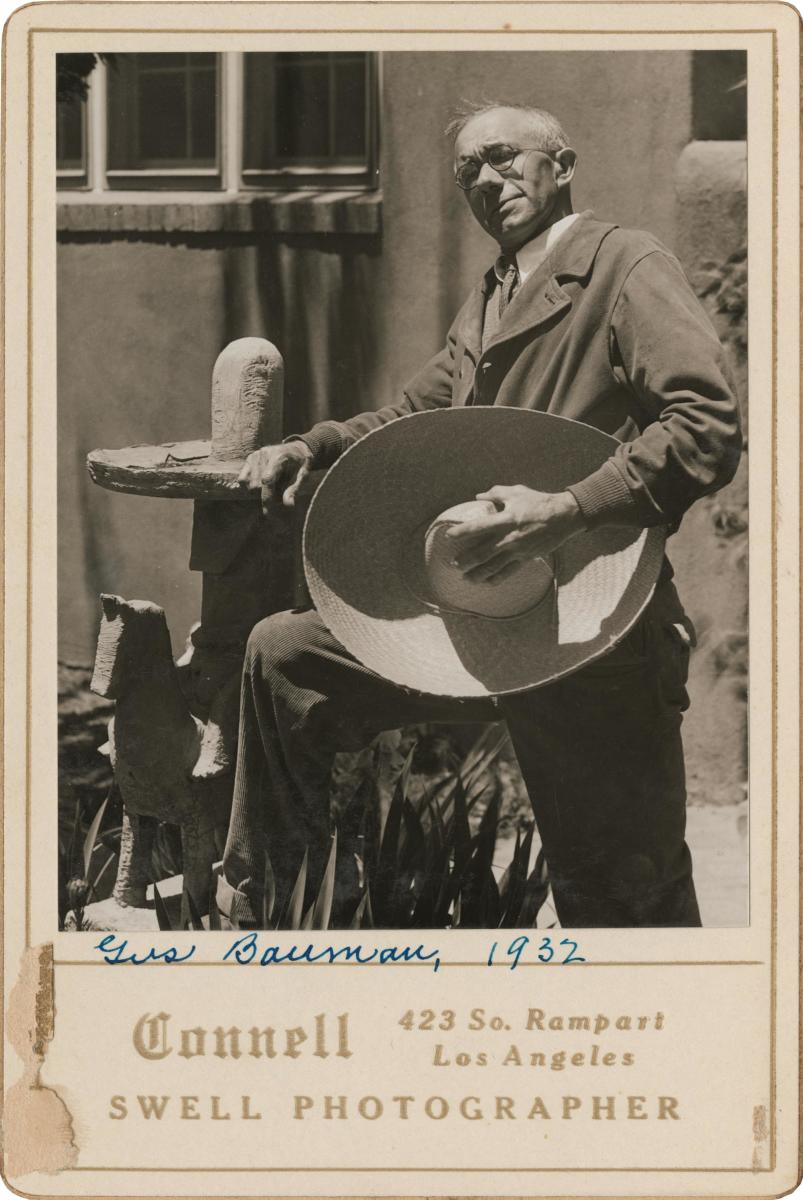 A 1932 portrait of the artist in Santa Fe (with a jaunty sombrero). Photograph courtesy of Palace of the Governors Photo Archives (NMHM/DCA) 059739.
A 1932 portrait of the artist in Santa Fe (with a jaunty sombrero). Photograph courtesy of Palace of the Governors Photo Archives (NMHM/DCA) 059739.
But it wasn’t simply a high-desert landscape that kept the Southwestern inspiration flowing in Baumann’s work for more than 50 years. It wasn’t even the oft-praised quality of light, which had already lured many of his fellow transplants in the burgeoning Santa Fe Art Colony. Using old European techniques of printmaking to illuminate the American Southwest, Baumann also drew on long-established traditions of Spanish Colonial and Native American artists.
Those cultural influences are at the heart of Go West Said a Small Voice: Gustave Baumann and Dreams of New Mexico, an exhibition at the New Mexico Museum of Art, in Santa Fe, through February 13, 2022. Go West curator Jana Gottshalk says she wanted to contextualize Baumann beyond his popular depictions of saturated yellow aspens and blooming ocotillo.
“There was a lot going on before Gustave Baumann got here,” she says. “I wanted to acknowledge what he saw when he came, independent of him, and to pay tribute to the strong culture that’s still here.” The exhibition’s title is taken from an undated color woodcut in the museum’s collection that shows a small, childlike figure striding forward. The pronouncement above it, go west said a small voice, seems to sum up the intuitive pull of New Mexico for Baumann and other early-20th-century artists.
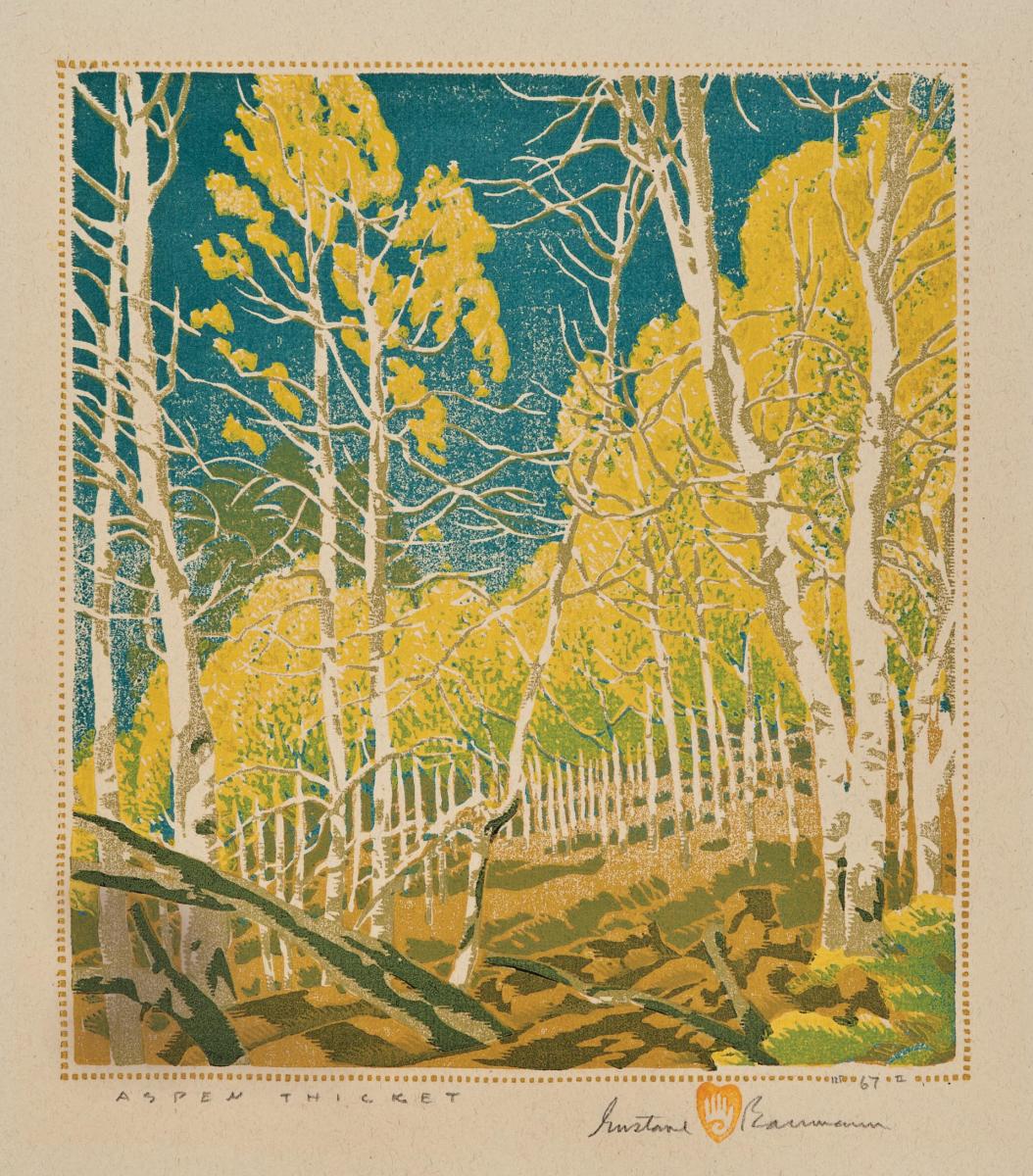 Aspen Thicket, a 1943 color woodcut by Gustave Baumann. Photograph courtesy of New Mexico Museum of Art (955.23G); Photo by Blair Clark.
Aspen Thicket, a 1943 color woodcut by Gustave Baumann. Photograph courtesy of New Mexico Museum of Art (955.23G); Photo by Blair Clark.
On a visit to the art museum before the show opens, Gottshalk leads me to the basement, which holds staff offices and the collections vault. It’s also hallowed Baumann ground. That subterranean cavern enticed him to stay in town after the museum offered it to him for a workshop. Here, more than a century later, Gottshalk lays out a few of the juxtapositions she crafted for Go West.
Alongside Baumann’s prints, she presents examples of similar themes and subject matter by New Mexico artists past and present. They include an unknown santero referred to as the Eighteenth-Century Novice, Baumann contemporaries Cady Wells and Gene Kloss, and modern-day santeros Gustavo Victor Goler and Arthur López.
“I started with the idea that he’d done this portfolio of santos,” says Gottshalk, referring to the prints of Catholic saints that Baumann intended to make into a book called New Mexico Santos. A circa 1928 Baumann woodcut of San Francisco de Asís depicts the friar clutching a skull and wielding a cross amid the high-desert landscape, with his namesake Cathedral Basilica of St. Francis of Assisi tilting charmingly in the background.
Next to Baumann’s print, Gottshalk points to painter Marsden Hartley’s 1919 still life El Santo. The Hartley painting provides context from a fellow modernist also drawn to New Mexico. El Santo features a saint portrait hanging on a wall with a black-on-black Pueblo pot and a colorful textile on a table in the foreground. Like Baumann’s print, the painting has a slightly askew perspective and a stew of cultural influences.
Another painting on wood is a modern-day rendering of the saint. Vicente Telles’s 2020 San Francisco shows Francis with a bowed head, holding and contemplating both a skull and a cross. The saint’s expression has a contemporary sort of pathos, but Telles’s rendering also speaks to more traditional santos, the kind that inspired both Hartley and Baumann. Through these groupings, it’s possible to see artistic traditions coming full circle.
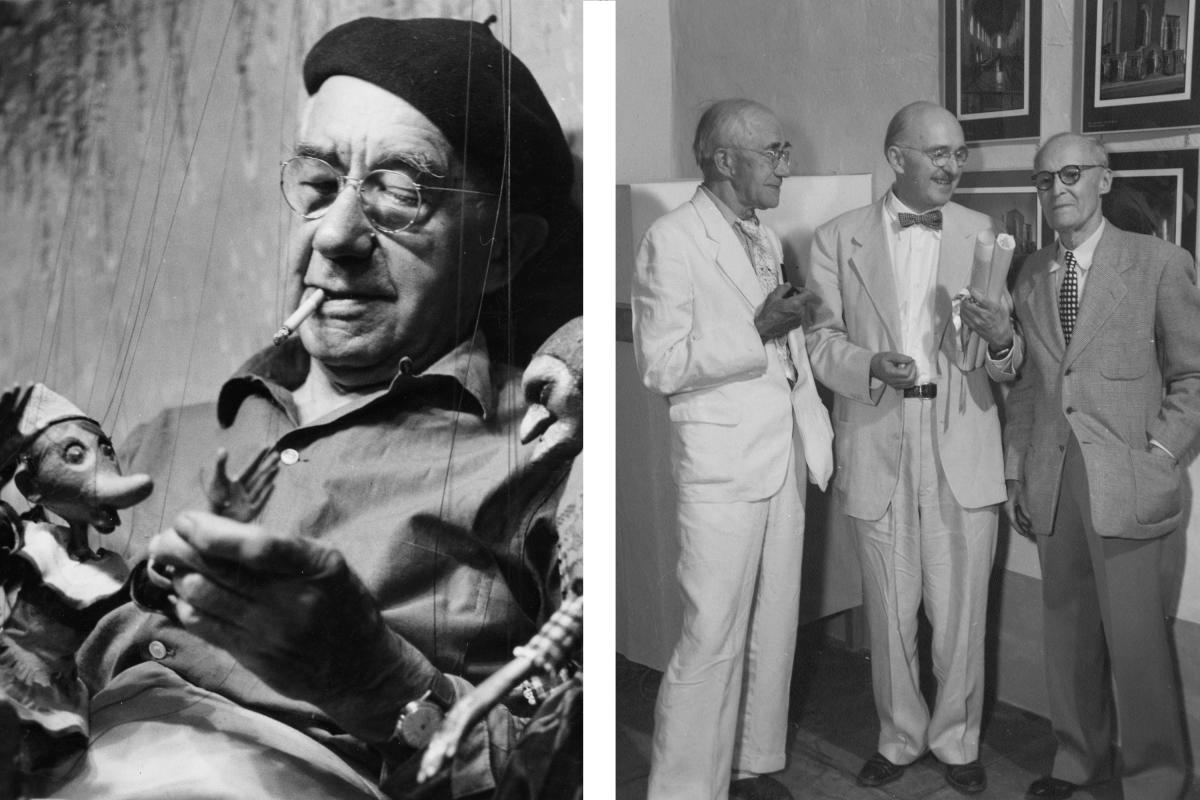 From left: Baumann with hand-carved marionettes that he used in performances at his Santa Fe home and Gustave Baumann, architect John Gaw Meem, and artist Ernest L. Blumenschein. Photographs courtesy of Palace of the Governors Photo Archives (NMHM/DCA) HP.2011.07.001. and Palace of the Governors Photo Archives (NMHM/DCA) 020749.
From left: Baumann with hand-carved marionettes that he used in performances at his Santa Fe home and Gustave Baumann, architect John Gaw Meem, and artist Ernest L. Blumenschein. Photographs courtesy of Palace of the Governors Photo Archives (NMHM/DCA) HP.2011.07.001. and Palace of the Governors Photo Archives (NMHM/DCA) 020749.
Tom Leech, director of the Palace Press, at the New Mexico History Museum, says Baumann was a pioneer in honoring Hispano-American folk art. “He was one of the very first people to recognize that work as an art form, before any of the scholarship on this stuff,” Leech says. “He was responding to it as art and as a true expression of a culture.”
The Palace Press will publish Gustave Baumann’s Book of the Saints this fall, with new prints of the artist’s New Mexico Santos made by Leech from the original blocks. At the history museum, Leech presides over a re-creation of Baumann’s Santa Fe studio, which includes the artist’s original tools and materials and a Reliance Midget hand press Baumann used for most of his printmaking after 1917. “I see him as being a real modernist,” Leech says of the artist’s hand-mixed inks. “If you look at the colors he was using, Matisse was using those colors. Baumann was looking at things through a different lens.”
The Southwest permanently changed the artist’s filter. Leech points out Baumann’s penchant for using cream or yellow paper, instead of white, for his prints. “He started with the atmosphere we see here in New Mexico, where everything is sort of superimposed on this brown,” he says. “It worked its way into his coloration.”
 From left: The Virgin, a 1938 print by Manville Chapman. San Francisco, a 2020 retablo by Vicente Telles. Photographs courtesy of New Mexico Museum of Art/ Public Buildings Service, U.S. General Services (739.23G); Vicente Telles, Photo by Blair Clark.
From left: The Virgin, a 1938 print by Manville Chapman. San Francisco, a 2020 retablo by Vicente Telles. Photographs courtesy of New Mexico Museum of Art/ Public Buildings Service, U.S. General Services (739.23G); Vicente Telles, Photo by Blair Clark.
At the house and studio Baumann built in 1923 just off Old Santa Fe Trail, many walls were painted by the artist in his signature mustard hue, with a mottled effect achieved with a sponge. The house’s owner, Nancy Meem Wirth, has kept the artist’s residence as it was in Baumann’s lifetime, complete with its many signature decorative flourishes. “His art was really his life,” she says.
Much of that art was also influenced by Native American culture. A Baumann print showing deer-hunt pictographs from Frijoles Canyon hangs above the fireplace in the house’s octagonal front room, which is also banded with painted shapes based on Pueblo motifs.
Go West zooms out from its focus on Baumann to emphasize these influences. In the exhibition, Baumann’s hand-carved wooden marionette figures, used in rollicking holiday performances by the artist’s family and friends, occupy the same space as a contemporary Cochiti figurine of an opera singer by Pueblo artist Virgil Ortiz. There’s also a large carved marionette by Armond Lara, who is of Mexican and Navajo heritage.
In this curated environment, Baumann’s puppets are no longer simply characters, replicas of which now get trotted out by the museum for Christmastime plays. They can, instead, be viewed as part of a long tradition of figure making in the Southwest.
 Española, New Mexico, a 2000 silver gelatin print by Norman Mauskopf. Photograph courtesy of New Mexico Museum of Art (2014.14.6).
Española, New Mexico, a 2000 silver gelatin print by Norman Mauskopf. Photograph courtesy of New Mexico Museum of Art (2014.14.6).
The catalog from a 1921 New Mexico Museum of Art exhibition of “Santa Fe Artists” puts these touchstones into perspective. Of the newer artists, including Baumann, the essayist writes that they influence “each other only indirectly although working in the same environment, choosing from its related themes, and seeking to solve the same problems of light and color.” A through line is drawn from Ancestral Puebloans to Baumann’s generation of artists, all of them sparked by the Land of Enchantment.
“Here in the Southwest, a distinctive American art had its beginnings and found expression … ages ago,” reads the catalog. “The artist of today, influenced by the same urge and environment, is also creating an art that is expressive of America.”
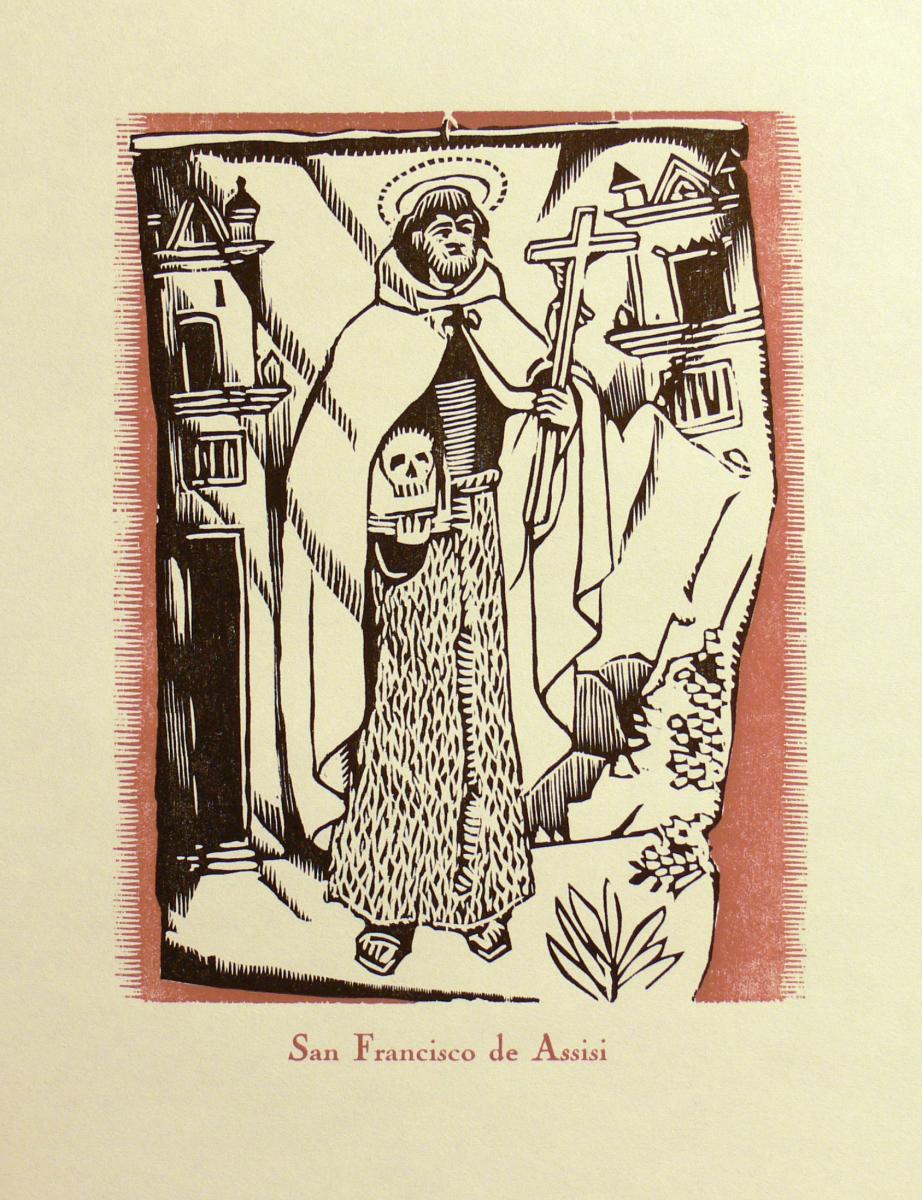 San Francisco de Assisi, a 1928 print by Baumann and fellow printer Willard F. Clark. Photograph courtesy of New Mexico Museum of Art (2010.28.4).
San Francisco de Assisi, a 1928 print by Baumann and fellow printer Willard F. Clark. Photograph courtesy of New Mexico Museum of Art (2010.28.4).

IN BAUMANN'S STEPS
See. Go West Said a Small Voice: Gustave Baumann and Dreams of New Mexico runs August 14, 2021, through February 13, 2022, at the New Mexico Museum of Art. 107 W. Palace Ave., Santa Fe; 505-476-5072
Visit. The Palace Print Shop and Bindery, which includes a re-creation of Baumann’s workshop, is open to visitors at the New Mexico History Museum. 113 Lincoln Ave.; 505-476-4200
Read. Gustave Baumann’s Book of the Saints, by Tom Leech and Carmella Padilla, with a previously unpublished essay by author and Baumann compatriot Mary Austin (1868–1934), is forthcoming from the Palace Press this fall. Published in 2020, Indian Pottery Old and New is the Palace Press’s expanded version of Baumann’s 1919 book, printed with his original blocks and on the remaining stock of the artist’s Arak paper.


